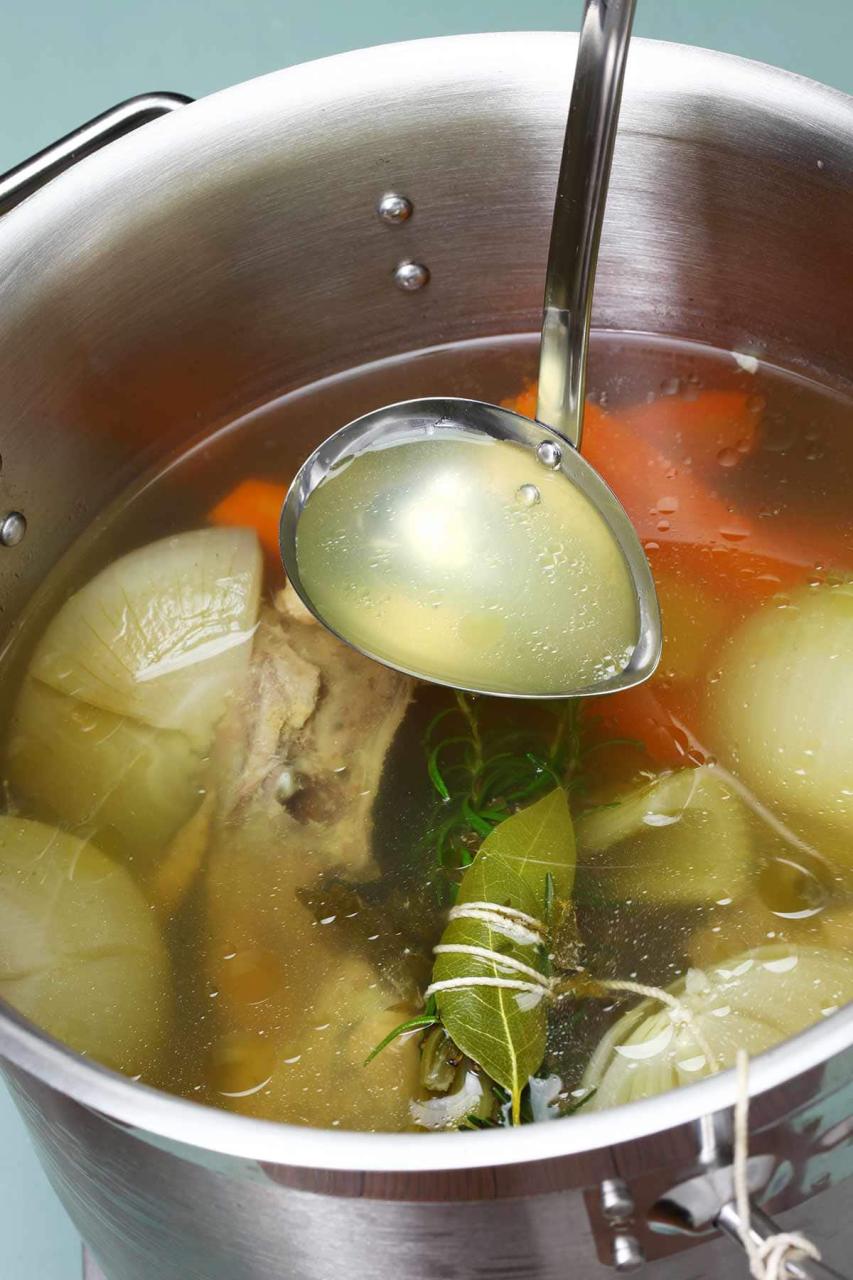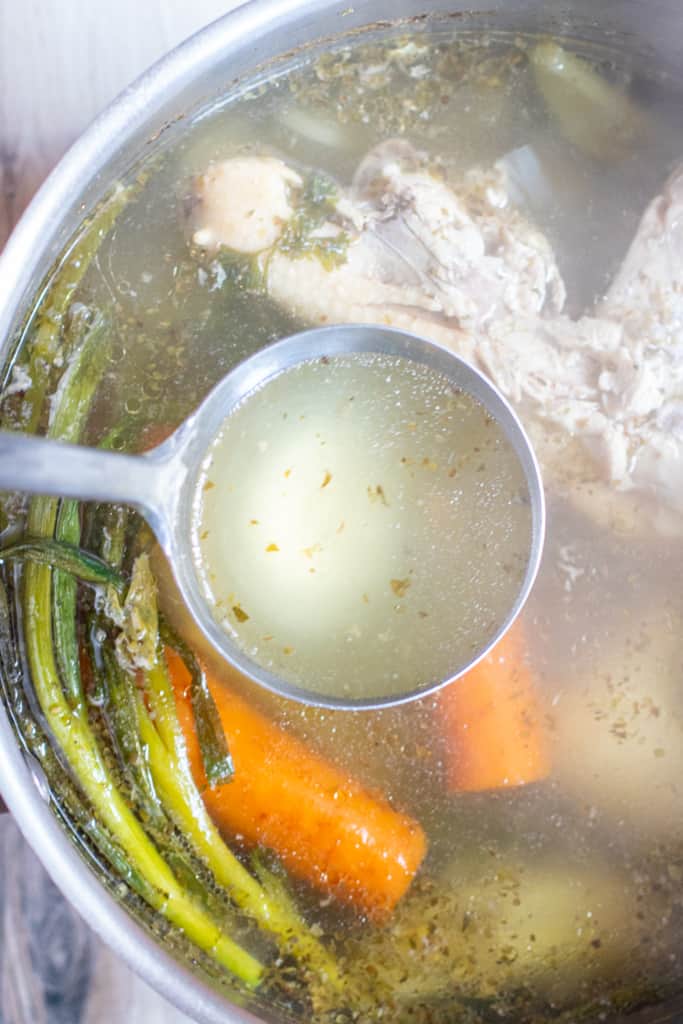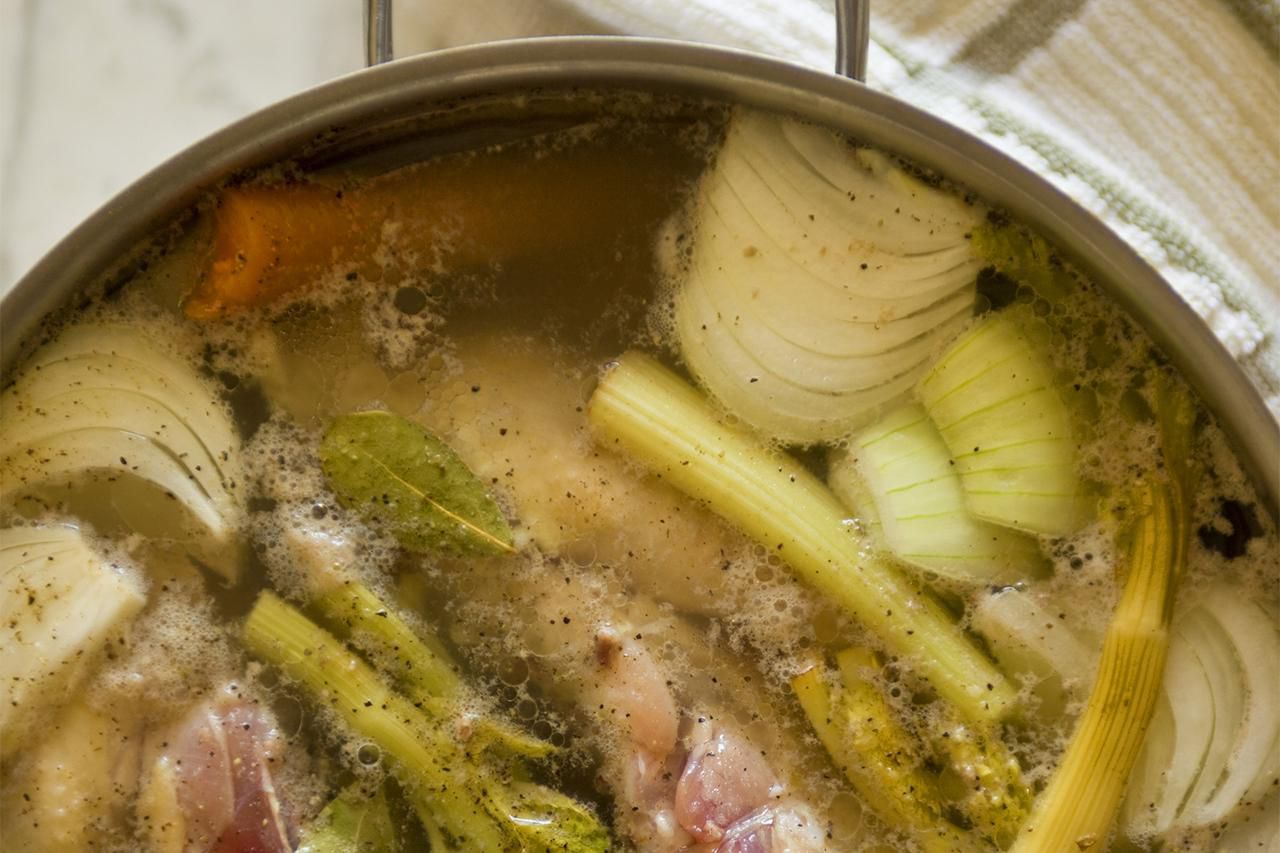The kitchen, often the heart of a home, has a way of coming alive with the simmering of a pot on the stove, especially when it’s filled with the makings of chicken stock. This golden elixir is the foundation of countless recipes, a building block of flavor that can elevate even the simplest dish to new heights. The act of making chicken stock from scratch is a ritual steeped in patience and care, a slow melding of ingredients that fills the space with an aroma both comforting and familiar.
My own journey to crafting homemade chicken stock is rooted in a desire for wholesomeness and depth in my cooking. There’s a profound satisfaction in knowing that the meals I serve to my family and friends start with such a pure, homemade element. It’s about taking control of the ingredients, reducing waste by using leftover bones and vegetable scraps, and infusing each batch with a personal touch that no store-bought version could ever match.
There’s also a sense of thrift and resourcefulness in making your own stock, a nod to the times when nothing went to waste in the kitchen. It’s a quiet celebration of flavors, where the humblest parts of the chicken become something treasured. In this blog post, I’ll share not just a recipe, but a piece of my heart, a reflection on the joys of creating something so fundamentally nourishing from simple, honest ingredients.
Chicken Stock Recipe

Chicken stock is a fundamental ingredient in culinary arts, serving as the base for soups, sauces, gravies, and a multitude of other dishes. It is created by simmering chicken bones, often with leftover meat, alongside aromatic vegetables like onions, carrots, and celery, as well as herbs and spices. The slow cooking process extracts flavors, minerals, and gelatin from the bones, resulting in a rich, savory liquid that enhances the depth and complexity of any dish it’s used in.
Homemade chicken stock is generally preferred over store-bought versions due to its superior flavor and the absence of preservatives and artificial additives. Making stock at home also allows for customization according to personal taste preferences and dietary needs. Additionally, it’s an economical way to utilize leftover chicken carcasses and vegetable scraps, reducing food waste while creating a nutritious and versatile kitchen staple.
In summary, chicken stock is a cherished element in the kitchen, valued for its ability to transform and elevate the taste of recipes, while embodying the principles of resourcefulness and tradition in cooking.
Chicken Stock
Homemade Chicken Stock from Carcass With this recipe we can get a delicious, very nutritious homemade chicken stock. This is a method used in most restaurants that is why I am bringing this chicken stock recipe today. You can cook a batch of it and freeze it in plastic bags, and have it ready for your soups or sauces. You can also pour the chicken stock in your ice trays and use each little square of chicken stock when needed.
Prep Time 15 minutes mins
Cook Time 3 hours hrs
3 hours hrs 15 minutes mins
Course Meat and Chicken
Cuisine International
Servings 8 people
Calories 364 kcal
- 8 cups of water
- Chicken bones backs, necks, carcasses, and/or tights or wings
- 2 tablespoons of grape seed oil
- 1 Yellow onion
- 2 carrots
- 2 Celery sticks
- 3 Garlic cloves
- 3 Bay leaves
- 2 tablespoons dry thyme or one sprig fresh thyme
- Salt
CHOP onion coarsely
CHOP celery coarsely
PEEL and CUT carrots in pieces of about 1 inch
CRUSHED garlic
HEAT the oil over medium heat in a 7 -8 quart stock pot
ADD the onion and cook until transparent
ADD garlic and continue cooking
ADD carrot and celery
COOK these vegetables, stirring frequently until they are soft and, about 8 -10 minutes.
ADD the water, thyme and bay leaves and bring to a boil.
ADD the chicken bones and bring to a boil, then turn the heat to low
SIMMER for about 2½ to 3 hours. Keep adding water as needed
SKIM the white foam from the top of the stock.
REMOVE from heat and let cool down completely
STRAIN the stock through a fine-mesh sieve, discarding the solids
PACK in individual plastic bags or ice trays and don’t forget to add the date to them. You can freeze for up to 2 months.
Keyword Chicken bones, water
How to make Chicken Stock using slow cooker

The slow cooker, a steadfast companion in the kitchen, transforms the humble task of making chicken stock into a soothing ritual. As I layer the bones, vegetables, and herbs, there’s a sense of building the foundation for countless meals to come. The low and slow simmer coaxes out the flavors gently, melding them into a rich tapestry that becomes more than the sum of its parts. There’s comfort in knowing that as the day unfolds, the slow cooker is doing its quiet work, infusing my home with the promise of nourishing soups and stews. This method feels like an homage to the time-honored traditions of cooking, where patience yields the deepest flavors and the most heartfelt meals.
Tips for making Chicken Stock

Cooking Tips
Making chicken stock is akin to weaving a tapestry of flavors, where each ingredient contributes to the overall depth. My approach is to gently simmer the bones and vegetables, allowing time for their essence to infuse the liquid. I find that adding a touch of acidity, like a splash of apple cider vinegar, helps extract the minerals from the bones, enriching the stock with nutrients and complexity. Straining it through a fine-mesh sieve ensures a clarity that’s not just visual but also taste-wise, resulting in a clean, pure broth. This process is a quiet testament to the beauty of slow cooking, where patience is rewarded with a stock that forms the soulful base for countless dishes.
Serving suggestions

Serving homemade chicken stock is akin to sharing a culinary secret, a base that transforms good dishes into great ones with its subtle yet profound depth. I cherish presenting it steaming in a bowl, perhaps garnished with a sprig of fresh herbs for an elegant touch. It’s the perfect start to a comforting soup or the hidden hero in a risotto, quietly underpinning the dish with its rich layers. Offering chicken stock is more than just serving a broth; it’s imparting a foundation of flavor, a liquid whisper of the care and time invested in its creation. It’s a simple gesture that elevates meals and warms hearts, embodying the essence of home cooking.
Top 5 FAQs about Chicken Stock
- What is the difference between chicken stock and chicken broth? Chicken stock tends to be made more from bony parts, whereas chicken broth is made more out of meat. Stock generally has a fuller mouth feel and richer flavor, due to the gelatin released by long-simmering bones. Broth is often lighter and seasoned to taste on its own.
- How do you make chicken stock? To make chicken stock, one typically combines chicken bones (with or without some meat), vegetables like onions, carrots, and celery, and aromatics such as bay leaves, peppercorns, and parsley in a large pot. This mixture is covered with water and slowly simmered for several hours, allowing the flavors to infuse. The stock is then strained to remove the solids.
- Can you make chicken stock from a cooked chicken carcass? Yes, making stock from a cooked chicken carcass is an excellent way to use the entire bird. After carving off the meat for other dishes, the remaining bones and any leftover skin and cartilage can be used as the base for a stock, along with vegetables and aromatics.
- How long does homemade chicken stock last in the fridge? Homemade chicken stock will typically last about 4-5 days in the refrigerator. To extend its shelf life, it can be frozen where it can last for up to 6 months. It’s important to cool the stock quickly before refrigerating or freezing to minimize the risk of bacterial growth.
- What can you substitute for chicken stock? If you don’t have chicken stock, common substitutes include vegetable stock, beef stock, or using bouillon cubes or granules dissolved in water. The choice of substitute might vary based on the desired flavor profile of the dish being prepared. In a pinch, even plain water can be used, although the resulting dish may lack some depth of flavor.
In conclusion, chicken stock is a cornerstone of culinary tradition, a versatile and essential ingredient that imparts depth and nuance to a myriad of dishes. Its preparation, a gentle simmering of bones and aromatic vegetables, is an exercise in patience and subtlety, yielding a liquid rich with flavor and nourishment. The beauty of homemade chicken stock lies in its simplicity and the profound impact it has on the quality of our cooking. It’s a reminder of the foundational role that good ingredients and time-honored techniques play in creating dishes that resonate with warmth and comfort. Whether used as the base for a robust soup, the secret to a velvety sauce, or the subtle enhancer of a risotto, chicken stock is a testament to the craft of cooking, a humble yet powerful expression of the love and care we put into our food.




